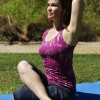Dancers, it’s time to roll out the mat.
Beyond the obvious benefits of increased flexibility and improved muscle tone, a dedicated yoga practice can enrich your experience in the dance studio and on stage.
Whether you are a student or professional, modern dancer or b-boy, a yoga practice is an investment in the sensitivity and wellness of your instrument.
It is a somatic practice—an exercise in observing the body from within through first-person perception. It is an opportunity to deepen your kinesthetic awareness—your consciousness of the placement and movement of your body in space. It is also focused time to integrate body, mind, and soul in a breath-centered and dynamic experience.
While the following merits of yoga are especially vital for dancers, the truth of the matter is, everyone, dancers and non-dancers alike, can benefit from yoga in the following ways.
Enhanced Sensitivity and Presence Through Imagery
Dance researchers generally agree that imagery, a mental representation of a visual or kinesthetic experience, is an effective tool in dance learning and performance. It is used, for example, to facilitate alignment by training dancers to perceive body segments and total body images from internal and external perspectives, to alleviate performance anxiety, and to encourage creativity in movement exploration.
Like many dance training modalities, yoga is an imagery-based practice. While every yoga teacher is different, drop in on a class, and you’ll likely hear cues to “shine your collarbones” and “make the backs of your thighs smile.” Even the names of many yoga poses recall known animals and actions to cue practitioners toward a certain experience of shape and energy.
The bottom line is, imagery in yoga is intended to enhance awareness of internal sensation and external relationships, and this can only fortify your work in the dance classroom, and more generally, your experience within your body as you navigate the world. Your sense of total body awareness may just trickle over to the stage and amplify the presence you experience within yourself and with those around you.
Improved Range of Motion in the Joints
Yoga is often touted as a means to tremendous flexibility. But remember, the term “flexibility” describes more than just the length of our muscles. It also speaks to the range of motion in our joints. While skeletal variations allow some people a naturally greater range of motion than others, we can all improve upon our joint flexibility.
Yoga is especially adept at this, as an asana practice, the practice of yoga poses, involves stretching not only our body’s major muscle groups, but also the smaller and deeper muscles that are harder to access. In many cases, yoga poses may lengthen and tone muscles that are closer to the joints themselves, thereby releasing tightness and freeing up joint range of motion. One example is Pigeon Pose, which stretches a deep outward rotator of the hip called the piriformis.
Furthermore, yoga’s approach to flexibility is more thorough than simple stretching. If “stretching” describes the general act of lengthening muscles, yoga involves “microstretching,” the practice of isolating many small stretches within a pose, such as lengthening the intercostal muscles between the ribs and the area between the naval and pubic bone in Warrior I Pose.
The real key here is that yoga poses both lengthen and tone your muscles. After all, your body’s ability to move, whether you’re dancing or walking up stairs to your apartment, is due in large part to the balance of your muscles’ length and contractility.
A Dynamic Experience of Time
While different idioms of dance and different styles of yoga involve kinetic motion to varying extents, generally speaking, yoga can provide a counter experience to the kinetic nature of your dance studies.
In yoga, we enter into poses gradually, taking time to set up a foundation, align our body parts, and ultimately shape into the expression of a pose. Instead of relating time to the tick of the clock or the pulse of the music. In yoga, time may be perceived internally through the tempo of our breath and rhythm of our heartbeat. Allowing ourselves the opportunity to be quiet and still and to tune into time in this way may result in the experience of time slowing down or speeding up.
When assuming a balancing pose in yoga, or an extension in a ballet adagio, or even when waiting in line at the grocery store, if we are practiced at turning inward, we may more sensitively experience our relationship to the ground and the minutia of shifting weight. And possibly, with more practice, we may eventually retain this cultivated sensitivity the next time we really get moving in dance class.
Perhaps next time you tip into your Horton Lateral T, or layout in jazz, or even sit down to enjoy your evening meal, you might get to feel like time stands still.
Love elephant and want to go steady?
Sign up for our (curated) daily and weekly newsletters!
Editorial Assistant: Heather Hendry/Editor: Bryonie Wise
Photo: Gina Sorensen











Read 0 comments and reply